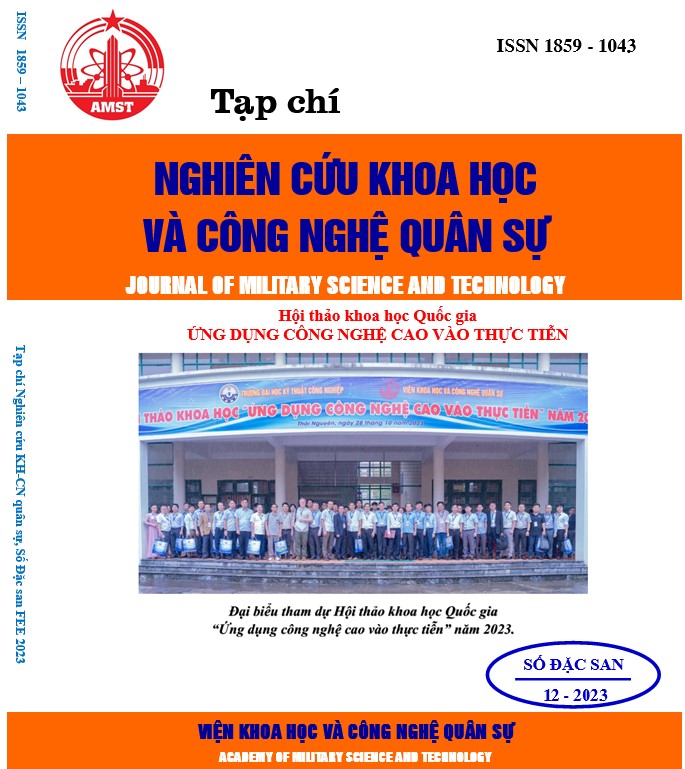Improvement of ride quality for a wheel loader with semi-active cab isolation system via fuzzy self tuning of PID controller
516 viewsDOI:
https://doi.org/10.54939/1859-1043.j.mst.FEE.2023.197-203Keywords:
Wheel Loader; Cab; Isolation system; Fuzzy-PID controller; Ride comfort.Abstract
Improving driver ride comfort of a wheel loader is important to avoid potential health hazards from the whole-body vibration. A fuzzy self-tuning of PID controller is designed to control the damping coefficient of Semi-active cab isolation system (SCIS) for a wheel loader. A dynamic model of a wheel loader is establish under survey conditions for analysis and evaluation. The r.m.s acceleration responses of the vertical driver's seat and pitch angle of vehicle body according to ISO2631-1 (1997-E) are chosen as objective functions. The effectiveness of the proposed control strategy is analyzed through simulations involving excitations for a random road profile in time domain. The proposed SCIS is simulated and analyzed by Matlab/Simulink software in comparison with a passive cab isolation system (PCIS) under survey conditions. The achieved results indicate that ride comfort effectiveness of a wheel loader with SCIS is better than PCIS under survey conditions. In addition, the study results are the initial basis for optimizing controller parameters.
References
[1]. NikolayPavlov et al, “Study of the wheel loader vibration with a developed multibody dynamic model,” MATEC Web of Conferences, Vol.133, 02007, (2017). DOI: https://doi.org/10.1051/matecconf/201713302007
[2]. Ryan P. Blood et al, “Whole-body vibration in heavy equipment operators of a front-end loader: Role of task exposure and tire configuration with and without traction chains,” Journal of Safety Research Vol.43, pp.357–364, (2012). DOI: https://doi.org/10.1016/j.jsr.2012.10.006
[3]. Zhao X. et al, “Assessment of wheel loader vibration on the riding comfort according to ISO standards,” Vehicle System Dynamics, Vol. 51(10), pp.1548-1567, (2013). DOI: https://doi.org/10.1080/00423114.2013.814798
[4]. Zhao X., Schindler C., “Evaluation of whole-body vibration exposure experienced by operators of a compact wheel loader according to ISO 2631-1:1997 and ISO 2631-5:2004,” International Journal of Industrial Ergonomics, Vol. 44 (6), pp. 840-850, (2014). DOI: https://doi.org/10.1016/j.ergon.2014.09.006
[5]. F. Chi, J. Zhou et al, “Avoiding the health hazard of people from construction vehicles: a strategy for controlling the vibration of a wheel loader,” International Journal of Environmental Research and Public Health, Vol.14 (3), pp. 275, (2017). DOI: https://doi.org/10.3390/ijerph14030275
[6]. X. Li, W. Lv, W. Zhang, and H. Zhao, “Research on dynamic behaviors of wheel loaders with different layout of hydropneumatic suspension,” Journal of Vibroengineering, Vol.19(7), pp. 5388–5404, (2017). DOI: https://doi.org/10.21595/jve.2017.18277
[7]. S. Wang et al, “Active control of hydropneumatic suspension parameters of wheel loaders based on road condition identification,” International Journal of Advanced Robotic Systems, Vol.15 (6), (2018). DOI: https://doi.org/10.1177/1729881418817425
[8]. L. Evers, F. Krause, and P. Vink, “Aspects to improve cabin comfort of wheel loaders and excavators according to operators,” Applied Ergonomics, Vol.34(3), pp.265–271, (2003). DOI: https://doi.org/10.1016/S0003-6870(03)00032-2
[9]. T. Wei, L. Zhiqiang, “Damping Multimode Switching Control of Semiactive Suspension for Vibration Reduction in a Wheel Loader,” Shock and Vibration, Vol.2019, Article ID 4535072,11 pages. DOI: https://doi.org/10.1155/2019/4535072
[10]. Rehnberg A., Drugge L., “Ride comfort simulation of a wheel loader with suspended axles,” International Journal of VehicleSystems Modelling and Testing, Vol.3 (3), pp.168-188, (2008). DOI: https://doi.org/10.1504/IJVSMT.2008.023836
[11]. R. Fales, E. Spencer et al, “Modeling and control of a wheel loader with a human-in-the-loop assessment using virtual reality,” Journal of Dynamic Systems, Measurement, and Control, Vol.127(9), pp.415–423, (2005). DOI: https://doi.org/10.1115/1.1985437
[12]. ISO 8068, “Mechanical Vibration-Road Surface Profiles – Reporting of Measured Data”, (1995).
[13]. ISO 2631-1, “Mechanical Vibration and Shock-Evaluation of Human Exposure to Whole Body Vibration-Part 1: General Requirements,” (1997).
[14]. A S. Emam, “Fuzzy Self Tuning of PID Controller for Active Suspension System,” Advances in Powertrains and Automotives, Vol.1(1), pp.34-41, (2015).
[15]. N. Ebrahimi, A.Gharaveisi, “Optimal Fuzzy Supervisor Controller for an Active Suspension System,” International Journal of Soft Computing and Engineering (IJSCE), Vol.2(4), (2012).
[16]. Van Quynh, L., Viet Ha, D., et al, “Improvement of ride comfort quality for an earth-moving machinery with semi-active cab isolation system,” E3S Web Conf. Vol.304, 02012, (2021). DOI: https://doi.org/10.1051/e3sconf/202130402012
[17]. Van Quynh, L. et al, “Optimal Design of Cab’s Isolation System for a Single-Drum Vibratory Roller,” Lecture Notes in Networks and Systems, Vol.178, pp. 619–627, (2021). DOI: https://doi.org/10.1007/978-3-030-64719-3_68
[18]. Van Cuong, B. et al, “Effects of Design Parameters of Cab’s Suspension System on an Agricultural Tractor Ride Comfort,”. Lecture Notes in Networks and Systems, Vol 602, pp 881–886, (2023). DOI: https://doi.org/10.1007/978-3-031-22200-9_93
[19]. Tran Thang Quyet, “Study on the ride effectiveness of hydraulic isolation system for construction machine cab,” Master of Science thesis, Thai Nguyen University of Technology, (2022).







